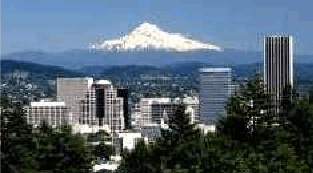The trail crosses a creek, rises steeply, emerges in a parking lot, enters the woods again, finally reaching another parking lot, a mansion nearby. While tourists wait for the opulent house to open, I walk to a spectacular view of the city and Mt. Hood, snowcapped in mid-summer.
Nearby, a group of Japanese boys are chatting with their American guide. "Fuji-san?" I offer. He grins. A potter married to a woman of Japanese descent, we talk of Japan. I him of visiting the poet Gary Snyder in Kyoto. "Is he still alive?" the potter asks. Indeed an era has passed! The Beat Movement as a metaphor for the urban artist, and for particular modes of observation some cells were discovered in the pons whose activity decreased to about half during non-REM sleep and was virtually arrested during REM sleep while the rest of the brain was active and near seizure levels. What did the cells contain? Norepinephrine and serotonin--the amines of the city, the flâneur has become a legendary icon of the architextual aesthetics of the urban novel, a figure who has become the subject of academic papers, and several of its members have recently passed away.
I continue to the Himalayan Trail,
then return to the mansion
and the slopes of Mt. Hood suspended
like a cloud in the sky.
